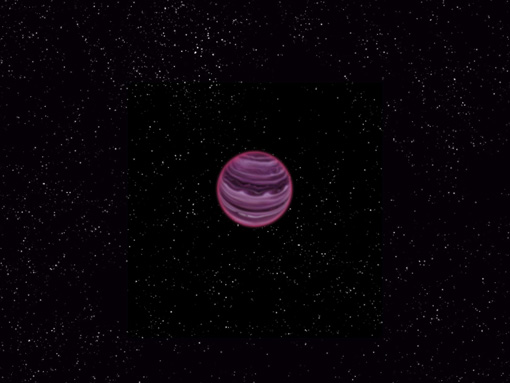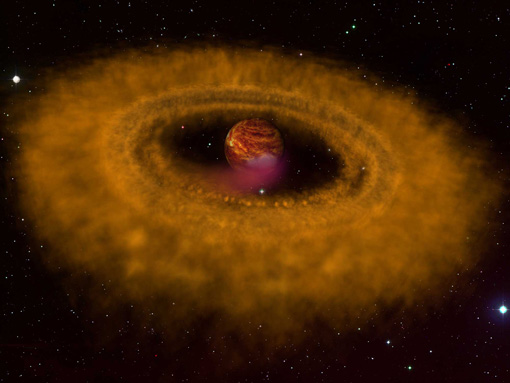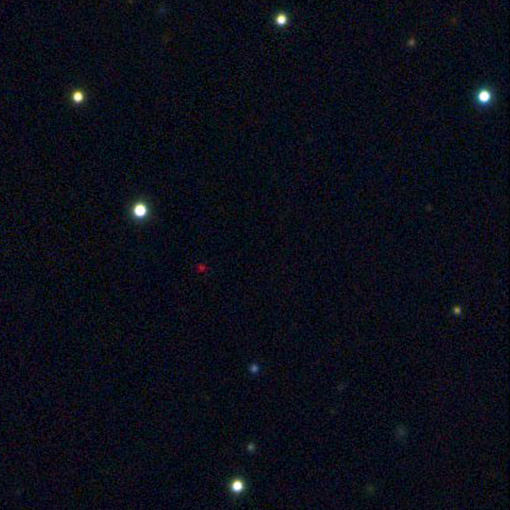|
|
MPIA Science Release 2013-09 Wednesday, October 9, 2013, 21:00 CEST (3 pm EDT, 9 am HAST) |
|
| German version |
Blurring the lines between stars and planets:
Lonely planets offer clues to star formation
Astronomers including Niall Deacon of the Max Planck Institute for Astronomy (MPIA) captured an image of an unusual free-floating planet. As the object has no host star, it can be observed and examined much easier than planets orbiting stars, promising insight into the details of planetary atmospheres. Can an object with as low a mass as this have formed directly, in the same way that stars form? Independent observations by a group led by MPIA's Viki Joergens suggest that this is the case: They discovered that a similar but much younger free-floating object is drawing material from its surrounding just like a young star. This has important consequences for star formation models in general.
 |
 |
|
Figure 1: Left: Artists impression of the solitary object PSO J318.5-22 discovered by a group of astronomers led by Michael Liu from the University of Hawaii, and including Niall Deacon from the Max Planck Institute for Astronomy. The planet has six times the mass of Jupiter, and does not orbit a star – making it an ideal target for detailed study. Right: Artists impression of the solitary object OTS44. Detailed studies by a team led by Viki Joergens showed that this object is forming in the same way stars do – by accreting matter at significant rates from a massive surrounding disk. Credit: MPIA / V. Ch. Quetz (left) / A. M. Quetz (right) [Larger version for download] |
||
| Contact | Background information | Questions and Answers | Images |
Things used to be so simple. On the one hand, there were stars: gigantic incandescent nuclear furnaces, emitting substantial amounts of light. On the other hand, there were planets, with much lower masses than stars, reflecting their host stars' light. Stars formed from the collapse of gigantic clouds of gas; planets formed in disks of gas and dust around their nascent host stars. In between there was the somewhat more ambiguous class of brown dwarfs: an intermediaries between planet and star, more massive than a planet, but with insufficient mass for nuclear fusion to ignite in the object's core, turning it into a star. Now, two new discoveries have blurred the border between these kinds of object even further, as they show that free-floating objects with planet-like masses very likely form like stars.
Using the Pan-STARRS 1 (PS1) telescope on Hawai'i, an international team of astronomers led by Michael Liu from the University of Hawaii has discovered an exotic young object with a mass six times that of the gas giant Jupiter, which is floating in space on its own – no host star in sight. The object, dubbed PSO J318.5-22, is located just 80 light-years away from Earth, in the constellation Capricornus. Its properties are similar to those of giant gas planets found orbiting around young stars. At an estimated age of 12 million years, it is an adolescent in terms of planetary or stellar ages.
Between 1995 and now, astronomers have found nearly a thousand extrasolar planets – but mostly by indirect methods, detecting a wobbling or dimming of the host stars induced by the planet. Only a handful of planets have been directly imaged, all of which are around young stars (less than 200 million years old). PSO J318.5-22 is very similar in mass, color, and energy output to those directly imaged planets.
Niall Deacon (Max Planck Institute for Astronomy), who is a co-author of the study, explains why this is a stroke of luck for astronomers: "Planets found by direct imaging are incredibly hard to study, since they are right next to their much brighter host stars. PSO J318.5-22 is not orbiting a star so it will be much easier for us to study. It is going to provide a wonderful view into the inner workings of gas-giant planets like Jupiter in an early phase of their evolution."
With just six times the mass of Jupiter, PSO J318.5-22 is one of the lowest-mass free-floating objects known, perhaps the very lowest. Ordinary planets are formed in a disk of gas and dust surrounding the embryo of the star they will eventually orbit. But how do solitary objects like this come into existence? Can objects this low-mass – free-floating planets and brown dwarfs in general – form in the same way as ordinary stars? An in-depth study of a different object, published at the same time by another group of astronomers which is led by MPIA's Viki Joergens, provides valuable evidence that they do.
Joergens and her team studied an object called OTS44, which is only about 2 million years old – in terms of stellar or planetary time-scales a newborn baby. The object has an estimated 12 Jupiter masses (marginally more massive than PSO J318.5-22). It is also floating through space without a close companion – but in a particularly interesting part of space: OTS44 is a member of the Chamaeleon star forming region in the Southern constellation Chamaeleon, at a little over 500 light-years from Earth, where numerous new stars are born from the collapse of dense clouds of gas and dust.
Just like a young star, OTS44 is surrounded by a disk of gas and dust. And, as Joergens and colleagues were able to show, the birth of this object isn't quite over yet: the astronomers split the light of OTS44 into its component colors using the SINFONI spectrograph at ESO's Very Large Telescope in Chile, discovering features that indicate OTS44 is still drawing in material from its disk at a substantial rate. Joergens explains: "Our observations show that, even now, there is still gas falling onto OTS44, increasing its mass."
Furthermore, combining data from numerous telescopes, including the Herschel Space Observatory, and carefully constructing a model of the free-floating planet, Joergens and her colleagues were able to show that the disk surrounding OTS44, traces of which had been found earlier, is quite substantial, with at least 30 times the mass of the Earth. Both the substantial disk and the infalling material (accretion) are telltale signs of the standard mode of star formation – an indication that there is no fundamental difference between the formation of a low-mass objects such as OTS44 and an ordinary star. OTS44 probably has the lowest mass of all objects where disk and infalling material have been detected.
Joergens continues: "If PSO J318.5-22 is an adolescent object, OTS44 is a newborn baby – and we can see that it has been born just like an ordinary star. For the researchers working on star formation, knowing that the same processes are at work all the way down to planetary-mass objects is key information."
Such objects do not fall clearly into any of the existing categories. Solitary planets or extremely low-mass brown dwarfs – if you want to play it safe, you can talk, more generally, about free-floating planetary-mass objects. Hubert Klahr (MPIA), an expert in simulations of star and planet formation, who was not involved in the research, comments: "This is another indication that our traditional categories of planets and stars, which are based on mass values, tell us nothing about the inner structure or the formation history of these objects."
| top |
Contact information
Viki Joergens
(first author, disk and accretion around a newly-born free floating planetary mass object)
Max Planck Institute for Astronomy
Heidelberg, Germany
Phone: (+49|0) 6221 – 528 464
Email: joergens@mpia.de
Niall Deacon
(co-author, newly discovered free-floating adolescence planetary mass object)
Max Planck Institute for Astronomy
Heidelberg, Germany
Phone: (+49|0) 6221 – 528 208
Email: deacon@mpia.de
Markus Pössel (public information officer)
Max Planck Institute for Astronomy
Heidelberg, Germany
Phone: (+49|0) 6221 – 528 261
Email: pr@mpia.de
| top |
Background information
The discovery of a substantial disk and strong accretion of OTS44 is being published by Astronomy & Astrophysics Letters. The authors of the paper are Viki Joergens (Max Planck Institute for Astronomy [MPIA] and ITA, University of Heidelberg), Mickael Bonnefoy (MPIA), Yao Liu (Purple Mountain Observatory), Amelia Bayo (MPIA), Sebastian Wolf (University of Kiel), Gael Chauvin (Institute of Planetology & Astrophysics Grenoble), and Patricio Rojo (University of Chile).
• ADS data base entry for the OTS44 article
The discovery paper of PSO J318-22 is being published by Astrophysical Journal Letters. The key authors of the paper are Michael Liu, Eugene Magnier (both IfA), Niall Deacon (MPIA), Katelyn Allers (Bucknell University), Trent Dupuy (Harvard-Smithsonian Center for Astrophysics), and Michael Kotson and Kimberly Aller (University of Hawaii at Manoa).
• ADS data base entry for the PSO J318.5-22 article
The Pan-STARRS1 Surveys (PS1) have been made possible through contributions of the Institute for Astronomy, the University of Hawaii, the Pan-STARRS Project Office, the Max-Planck Society and its participating institutes, the Max Planck Institute for Astronomy, Heidelberg and the Max Planck Institute for Extraterrestrial Physics, Garching, The Johns Hopkins University, Durham University, the University of Edinburgh, Queen's University Belfast, the Harvard-Smithsonian Center for Astrophysics, the Las Cumbres Observatory Global Telescope Network Incorporated, the National Central University of Taiwan, the Space Telescope Science Institute, the National Aeronautics and Space Administration under Grant No. NNX08AR22G issued through the Planetary Science Division of the NASA Science Mission Directorate, the National Science Foundation under Grant No. AST-1238877, the University of Maryland, and Eotvos Lorand University. Finding floating planetary-mass objects like PSO J318.5-22 was an important goal of the PS1 survey.
Herschel is an ESA space observatory with science instruments provided by European-led Principal Investigator consortia and with important participation from NASA. PACS has been developed by a consortium of institutes led by MPE (Germany) and including: UVIE (Austria); KU Leuven, CSL, IMEC (Belgium); CEA, LAM (France); MPIA (Germany); INAF-IFSI/OAA/OAP/OAT, LENS, SISSA (Italy); IAC (Spain). This development has been supported by the funding agencies BMVIT (Austria), ESA-PRODEX (Belgium), CEA/CNES (France), DLR (Germany), ASI/INAF (Italy), and CICYT/MCYT (Spain).
| top |
Questions and Answers
Which telescopes and instruments were used to discover infalling material and a substantial disk of the planetary mass object OTS44?
This object was first identified as very low-mass object in the Chamaeleon star forming region by Oasa, Tamura and Sugitani in 1999. The abbreviation 'OTS' used in OTS44's name stems from their initials. The object was first unambiguously identified as a substellar object by Kevin Luhman in 2004. Luhman showed that it has a mass close to the planetary border, which was confirmed later by Mickael Bonnefoy (MPIA). It is at the moment not possible to determine the exact mass of OTS44; estimates are in the range of 6 to 17 Jupiter masses with an average of 12 Jupiter masses.
Joergens and her colleagues observed OTS44 in the near-infrared using the SINFONI spectrograph at ESO's Very Large Telescope in Chile and discovered strong Hydrogen emission in the so-called Paschen beta line, which is evidence that OTS44 is drawing material from the surrounding disk at a significant rate. They also find that the amount of material that is accumulated by the object varies with time. The team analyzed in addition an optical spectrum of OTS44 taken by Kevin Luhman with the IMACS spectrograph at the Magellan I telescope. They find also in this spectrum strong Hydrogen emission of OTS44 – in this case in the so-called H-alpha line. This is further evidence that material is still falling onto OTS44 from its disk.
Furthermore, the team combined data from numerous telescopes including data taken with the Herschel Space Observatory by Paul Harvey, Thomas Henning (MPIA) et al. and carefully studied the amount of light coming from OTS44 at all wavelengths from the optical, to the near-infrared and far-infrared. They carefully constructed a model of the free-floating planetary mass object and its surrounding material and showed that the disk surrounding OTS44, traces of which had been found earlier by Luhman with the Spitzer telescope, is quite substantial, with at least 30 times the mass of the Earth. In this effort, they used theoretical models of France Allard for the contribution of the central object and of Sebastian Wolf and Yao Liu for the contribution of the disk.
Which telescopes and instruments were used to discover the solitary planet PSO J318.5-22, and what were the observations?
PSO J318.5-22 was discovered during a search for the failed stars known as brown dwarfs using the Pan-STARRS 1 (PS1) wide-field survey telescope on Haleakala, Maui. Due to their relatively cool temperatures, brown dwarfs are very faint and have very red colors. To circumvent these difficulties, Liu and his colleagues have been mining the data from the PS1 telescope. PS1 is scanning the sky every night with a camera sensitive enough to detect the faint heat signatures of brown dwarfs. PSO J318.5-22 was identified from its faint and unique heat signature. It stood out as an oddball, redder than even the reddest known brown dwarfs.
PS1 produces the equivalent of 60,000 iPhone photos every night. The total dataset to date is about 4,000 Terabytes, which is larger than the sum of the digital version of all the movies ever made, all books ever published, and all the music albums ever released.
The team followed up the PS1 discovery with multiple telescopes on the summit of Mauna Kea on the island of Hawaii. Infrared spectra taken with the NASA Infrared Telescope Facility and the Gemini North Telescope showed that PSO J318-22 was not a brown dwarf, based on signatures in its infrared light that are best explained by it being young and low-mass.
By regularly monitoring the position of PSO J318.5-22 over two years with the Canada-France-Hawaii Telescope, the team directly measured its distance from Earth. Based on this distance, about 80 light-years, and its motion through space, the team concluded that PSO J318-22 belongs to a collection of young stars called the Beta Pictoris moving group that formed about 12 million years ago. In fact, the eponymous star of the group, Beta Pictoris, has a young gas-giant planet in orbit around it. PSO J318-22 is even lower in mass than the Beta Pictoris planet and probably formed in a different fashion.
What is the classification issue with planets, stars, and brown dwarfs?
A star is an object sufficiently massive that, after it is formed, nuclear fusion (hydrogen burning) starts in the object's core. A brown dwarf is an object that does not reach the required mass and, hence, does not experience substantial hydrogen burning in its core – a "failed star". It does, going by a definition set by the International Astronomical Union, have sufficient mass, though, for heavy hydrogen (deuterium) to start fusion reactions in its outer layers – for a limited time. This distinguishes brown dwarfs from planets, in which no such fusion reactions take place. The minimum mass for deuterium fusion to happen is thought to lie around 13 Jupiter masses. By that definition, both OTS44 and PSO J318.5-22 could be called extremely low-mass brown dwarfs.
A number of astronomers have argued for a different definition, going by the way these objects are formed. For them, brown dwarfs are distinguished in that they form in the same way as stars – from the collapse of a cloud of gas and dust; not inside a disk surrounding a young star. By that definition, OTS44 and PSO J318.5-22 would both be extremely low-mass brown dwarfs.
| top |
 |
Figure 2: Discovery image of the solitary object PSO J318.5-22 discovered by a group of astronomers led by Michael Liu from the University of Hawaii, and including Niall Deacon from the Max Planck Institute for Astronomy. (Image size: 125 arc seconds on a side.) Credit: N. Metcalfe & Pan-STARRS 1 Science Consortium [Larger version for download] |
| top |
Images
 |
PR_2013_09_1left.jpg | JPG | RGB | 510 x 383 pxl 72 dpi |
53 KB |
| PR_2013_09_1left_gr.jpg | JPG | RGB | 1200 x 900 pxl 72 dpi |
164 KB | |
| PR_2013_09_1left_hr.jpg | JPG | RGB | 2000 x 1500 pxl 72 dpi |
176 KB | |
 |
PR_2013_09_1right.jpg | JPG | RGB | 510 x 383 pxl 72 dpi |
57 KB |
| PR_2013_09_1right_gr.jpg | JPG | RGB | 1200 x 900 pxl 72 dpi |
205 KB | |
| PR_2013_09_1right_hr.jpg | JPG | RGB | 2000 x 1500 pxl 72 dpi |
221 KB | |
 |
PR_2013_09_2.jpg | JPG | RGB | 510 x 510 pxl 72 dpi |
103 KB |
| PR_2013_09_2gr.jpg | JPG | RGB | 900 x 900 pxl 72 dpi |
240 KB | |
| PR_2013_09_2.tif | TIF | RGB | 900 x 900 pxl 300 dpi |
1.5 MB | |
Press Releases 2013